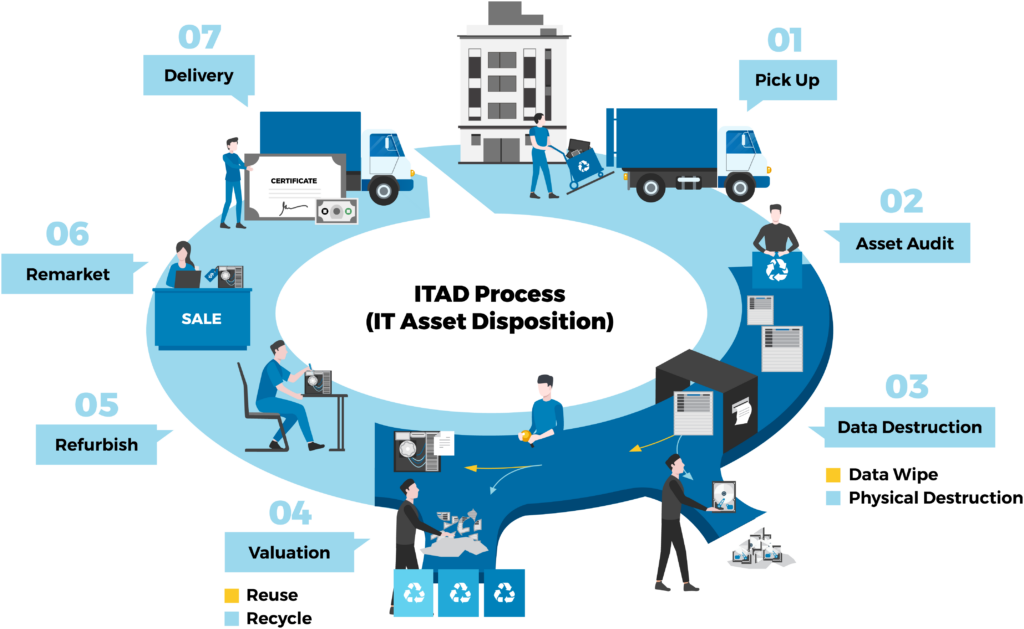
Introduction
In today’s rapidly evolving technological landscape, businesses frequently upgrade their computer systems to stay competitive. However, this constant cycle of upgrading leads to a significant challenge: business computer disposal. Proper disposal of outdated or unused computers is not only crucial for environmental sustainability but also for data security and regulatory compliance. This guide aims to provide business owners with a comprehensive understanding of computer recycling, focusing on key aspects such as the WEEE Directive, free e-waste collection, and secure data erasure. Additionally, we will explore the concepts of ITAD (IT Asset Disposal), and asset recovery and recycling.
Understanding the WEEE Directive
The Waste Electrical and Electronic Equipment (WEEE) Directive is a critical piece of legislation in the European Union that addresses the environmental impact of electronic waste. The directive aims to reduce the amount of e-waste generated and ensure that it is properly managed and recycled. For businesses, compliance with the WEEE Directive is essential to avoid legal penalties and contribute to environmental sustainability.
The WEEE Directive sets targets for the collection, recycling, and recovery of electronic waste. It requires businesses to separate and properly treat WEEE, ensuring that hazardous materials are safely disposed of and valuable materials are recovered for reuse. By adhering to the WEEE Directive, businesses can enhance their environmental performance and support the circular economy.
The Importance of Free E-waste Collection
One of the significant challenges businesses face when disposing of old computers is the cost associated with e-waste collection and recycling. Fortunately, Weee Recycle ICT offer free e-waste collection services, making it easier for businesses to dispose of their electronic waste responsibly. Our service includes the collection, transportation, and secure data destruction at no cost to the business.
Free e-waste collection services are beneficial for several reasons:
- Cost Savings: Businesses can save on disposal costs, making it more financially feasible to recycle old computers.
- Convenience: Our service provides convenient pickup options, reducing the logistical burden to your business.
- Environmental Impact: By utilizing free e-waste collection services, businesses can ensure that their electronic waste is recycled properly, reducing the environmental impact.
Secure Data Erasure: Protecting Your Business
When disposing of old computers, one of the most critical considerations is data security. Simply deleting files or formatting a hard drive is not sufficient to ensure that sensitive data cannot be recovered. Secure data erasure is a process that permanently removes all data from a storage device, making it unrecoverable.
Weee Recycle ICT offer several methods of secure data erasure, including:
- Software-Based Erasure: This method uses specialized software to overwrite the data on a storage device multiple times, ensuring that it cannot be recovered.
- Degaussing: This process involves using a powerful magnetic field to erase data from magnetic storage devices, such as hard drives.
- On-Site Physical Destruction: Physically destroying a storage device, such as shredding or crushing, ensures that the data cannot be recovered.
For businesses, secure data erasure is essential to protect sensitive information and comply with data protection regulations. Weee Recycle ICT is a certified data erasure provider who ensures that the process is carried out correctly and that a certificate of data destruction is provided.
ITAD: IT Asset Disposal
IT Asset Disposal (ITAD) is a comprehensive approach to managing the end-of-life cycle of IT assets, including computers, servers, and other electronic devices. ITAD services encompass various processes, such as secure data erasure, recycling, and remarketing of IT assets. By partnering with Weee Recycle ICT, a reliable ITAD provider, businesses can ensure that their IT assets are disposed of securely and responsibly.
Key benefits of ITAD services include:
- Data Security: Weee Recycle ICT uses advanced data erasure techniques to ensure that all data is securely removed from IT assets.
- Environmental Compliance: We adhere to environmental regulations, ensuring that electronic waste is recycled properly.
- Asset Recovery: Often we include the remarketing of IT assets, allowing businesses to recover value from their old equipment.
Asset Recovery and Recycling
Asset recovery and recycling is a crucial aspect of IT asset disposal. This process involves recovering valuable materials from old IT assets and recycling them for reuse. By doing so, businesses can reduce their environmental footprint and contribute to the circular economy.
The asset recovery and recycling process typically includes the following steps:
- Assessment: IT assets are assessed to determine their condition and potential value.
- Data Erasure: Secure data erasure is performed to ensure that all data is permanently removed from the devices.
- Refurbishment: Functional IT assets are refurbished and prepared for resale or redeployment.
- Recycling: Non-functional or obsolete IT assets are dismantled, and valuable materials are recovered for recycling.
Conclusion
Proper business computer disposal is essential for businesses to ensure data security, comply with environmental regulations, and contribute to sustainability. By understanding the WEEE Directive, utilizing free e-waste collection services, and implementing secure data erasure practices, businesses can effectively manage their electronic waste. Additionally, partnering with Weee Recycle ICT for IT asset disposal and asset recovery and recycling can help businesses maximize the value of their old IT assets while minimizing their environmental impact.
By following the guidelines outlined in this comprehensive guide, business owners can make informed decisions about computer recycling and contribute to a more sustainable future.
This guide provides a detailed overview of computer recycling for businesses, covering essential topics such as the WEEE Directive, free e-waste collection, secure data erasure, ITAD, and asset recovery and recycling. By incorporating these practices into their operations, businesses can ensure responsible and sustainable disposal of their IT assets.
References
